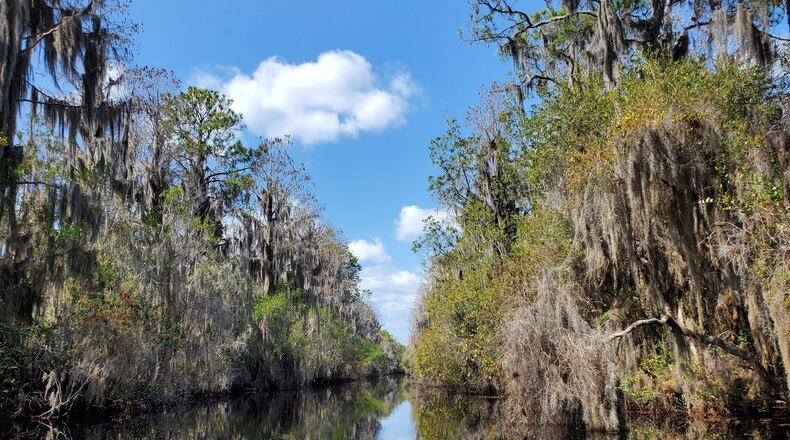If you’ve ever had the opportunity to visit the Okefenokee Swamp in southeast Georgia, you know that it is a unique and irreplaceable treasure.
In the 1970s, Newt Gingrich was teaching environmental studies at what was then West Georgia College in Carrollton (now the University of West Georgia) and take his students on field trips to the Okefenokee Swamp. Just visualize it: A Volkswagen camping van, leaky tents, canoes that flipped over – and a professor with heavy sideburns, thick dark plastic glasses and a turtleneck. His family, including his daughter Jackie, would come along on some of those trips. For a grammar school child, it was heaven on earth.
The Okefenokee is North America’s largest blackwater wetland. It includes nearly 700 square miles of land, with 6,500-year-old peat islands that float on the water. Called the “Land of Trembling Earth,” by the Native Americans, there is nowhere else like the Okefenokee Swamp. The stars are more visible in the night sky due to low light pollution, and the area is inhabited by alligators, ducks, snakes, Sandhill cranes, and otters. It’s been designated a National Wildlife Refuge; it simply could not be replaced if it was harmed.
Credit: Ambassador Callista Gingrich
Credit: Ambassador Callista Gingrich
Some 27 years ago, DuPont Chemical Corporation proposed mining titanium on 38,000 acres of land along Trail Ridge adjacent to the Okefenokee Swamp. At that time, Gingrich was serving as Speaker of the House, and leaders from Washington to Atlanta seemed united in opposing this foolhardy plan. Then-Interior Secretary Bruce Babbitt, an appointee of President Bill Clinton, urged DuPont to abandon its plans. Democratic Georgia Gov. Zell Miller did as well. This was a bipartisan issue, and we were in total agreement.
It was decided that mining on Trail Ridge adjacent to the Okefenokee Swamp simply presented too great a risk to the wetland environment. DuPont ultimately abandoned its plans. Today, roughly 16,000 acres of the proposed mining site have been permanently protected from future mining operations, but tens of thousands of acres of Trail Ridge still remain susceptible to mining.
Unfortunately, the Okefenokee now faces a similar threat. There is a proposal to begin mining for titanium-bearing minerals on a 700-acre portion of the site. It is under permit review by the Georgia Environmental Protection Division to determine whether or not to allow digging of 50-foot deep pits into Trail Ridge, the eastern border of the swamp which serves as a dam holding water in the swamp.
While the Alabama company proposing the mine has claimed that the operation will have limited to no impact to the Okefenokee National Wildlife Refuge, nearly 100 scientists have written an open letter opposing such mining.
“A majority of established research supports the claims that mining close to the swamp has a high likelihood of causing permanent damage to the swamp and surrounding areas,” they wrote.
Just think about it: If you have land next to a swamp, and you dig up the land to mine, the water level in the swap will likely be affected. It’s just common sense.
The U.S. Fish & Wildlife Service and National Park Service hydrologists expect that mining will lower water levels in the swamp, harming swamp-based recreation and tourism worth $65 million to the region annually.
They also warn that mining-induced drought would heighten the chances of more frequent and extreme wildfires that could devastate commercial forests surrounding the swamp. The most expensive fire in Department of Interior’s history is the Okefenokee’s Big Fire of 2007. It spread across the entire swamp to adjacent private lands in Georgia and Florida, destroying $113 million of private timber and costing $100 million to put the fire out. We cannot increase the risk of that happening again.
The Georgia General Assembly has the opportunity to pass historic bipartisan legislation by voting in favor of the Okefenokee Protection Act. Introduced by Republican leaders, House Bill 71 is now co-sponsored by over half the Georgia House of Representatives from both parties.
We urge all Georgia representatives and senators to take up this important matter to conserve Okefenokee’s Trail Ridge, and for you to reach out and encourage your legislators to co-sponsor and pass the bill, as well. Together, we can make sure that the Okefenokee Swamp will be there for generations to come.
Once again, we can save the Okefenokee Swamp – this time forever.
Jackie Gingrich Cushman is an author and strategic consultant, and serves on the Advisory Board of the Trust for Public Land for Alabama and Georgia. She lives in Atlanta.
Newt Gingrich is a former Speaker of the U.S. House of Representatives and Congressman from Georgia. He is now chairman of Gingrich 360, a multimedia production company based in Arlington, Va.
Keep Reading
The Latest
Featured




